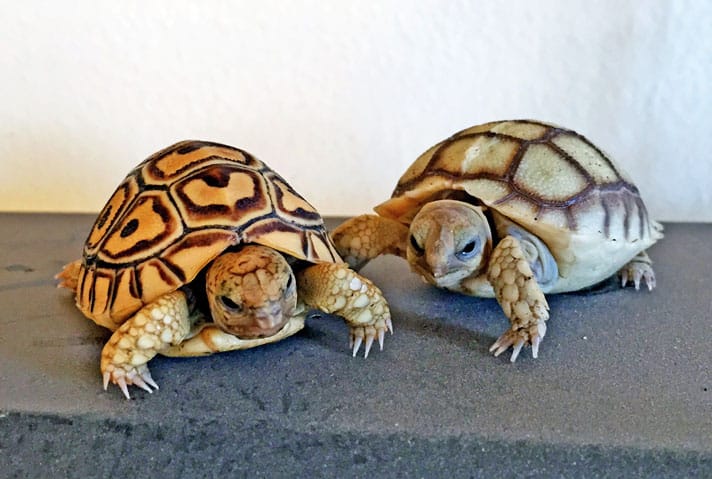Awesome beauty, a calm demeanor and a hefty size— what’s not to love about the leopard tortoise?
It isn’t a cunning killing machine stalking its prey across sub-Saharan Africa, and it doesn’t possess powerful canines that can take down animals with one swift bite to the neck. In fact, it moves rather slowly, grazing across the land and taking an occasional soak in a mud hole. It isn’t agile or stealthy, though it is deliberate in its motions as a more peaceful depiction of this continent’s great wildlife. In fact, it isn’t a big cat at all, though it does have a majesty all its own, due in part to an appearance that features a majestic pattern of beautiful, black rosettes on a light-colored background.
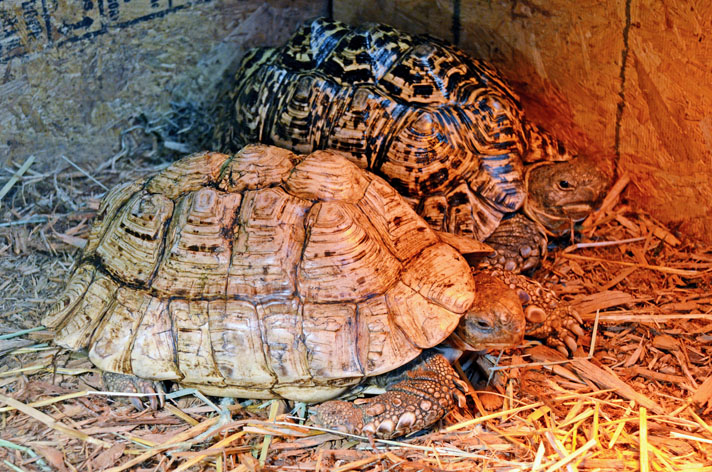
Chris leone
Shell patterns vary, and some leopard tortoises’ shells may even be patternless, such as the lighter-colored specimen in this photo of two males.
Stigmochelys pardalis: A Herculean Beauty
The leopard tortoise’s Latin name is Stigmochelys (meaning “marked or pointed tortoise”) pardalis (meaning “leopard”). It is the world’s fourth-largest tortoise species, with adults sometimes surpassing 40 pounds and 18 inches in length. The once-valid subspecies known as the South African leopard tortoise (S. p. pardalis) typically reaches these dimensions, while the more common East African leopard tortoise (S. p. babcockii) remains smaller at around 12 to 16 inches and 14 to 20 pounds.
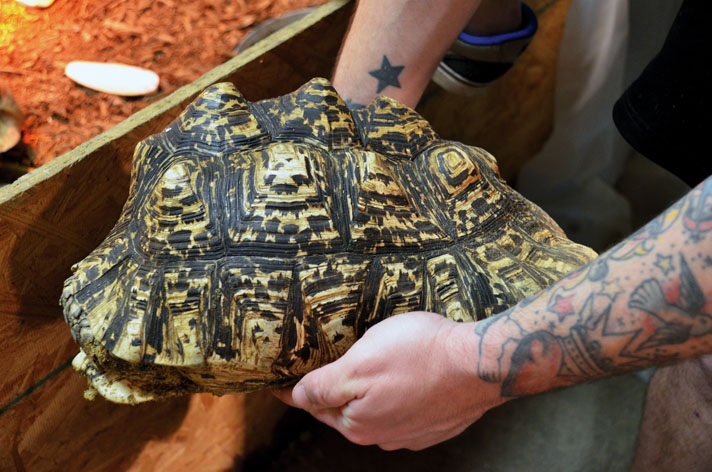
Chris leone
This leopard tortoise is exhibiting pyramiding of the carapacial scutes, a common condition among many individuals of this species.
Today, the leopard tortoises are grouped into one valid species with no recognized subspecies—a taxonomic update that is frequently debated. Several locales exist in nature, as is the case with other tortoise species, each with their own phenotypic traits. Those found in Ethiopia, for example, are referred to as giants, exceeding 25 inches in length.
The classic, unmistakable, leopard-like pattern covers the leopard tortoise’s highly domed shell. The ground color is horn to yellowish, with some specimens being almost black and others nearly patternless (usually the case in older animals). Considered one of the planet’s most beautiful chelonians, S. pardalis exhibits an extreme degree of contrast, especially in young, captive-raised animals. The black spotting on a bone-white carapace is eye-catching to just about anyone, and this is one reason why the leopard tortoise remains a favorite in the reptile community worldwide.
Leopard tortoises are strong, with a calm but herculean look. Long, heavily scaled, elephantine legs with impressive claws allow this tortoise to walk tall as it clambers across semi-arid grasslands from Sudan down to the southern cape in its native Africa.
Widespread in nature, the leopard tortoise is currently listed as a species of least concern on the IUCN’s Red List. However, although wild populations remain stable, they are, of course, subject to certain threats, including fires, electric fences and over-collection. Human consumption of leopard tortoises in Africa, as well as overdevelopment of its habitat by foreign contractors, may cause significant population declines in the future. As of 2001, the USDA banned the importation of leopard tortoises into the United States because they were known to carry ticks that harbored heartwater disease. This prohibition caused leopard tortoise prices in the American pet trade to soar. Captive-bred specimens are now prevalent in the pet trade, and the once-imported wild tortoises remain the founders for the species’ overall success rate in captive situations.
Sexual dimorphism is apparent in this species; males have a concave plastron, widened anal scutes, and large, thick tails. Females are typically larger, but many males can reach the same impressive size of the females. In nature, leopard tortoises may achieve sexual maturity in roughly 15 years, significantly longer than the approximately six to eight years it takes in captivity. Leopard tortoises are known to live for 40 to 100 years.
Baby Leopard Tortoise Care
Outdated information about tortoise husbandry abounds, and unfortunately often overshadows newer, updated information that is available to keepers today. Baby leopard tortoises, sadly, fall victim to the “old methods,” and despite the leopard tortoise’s success in captivity overall, many keepers have lost them because they follow old, outdated care information.
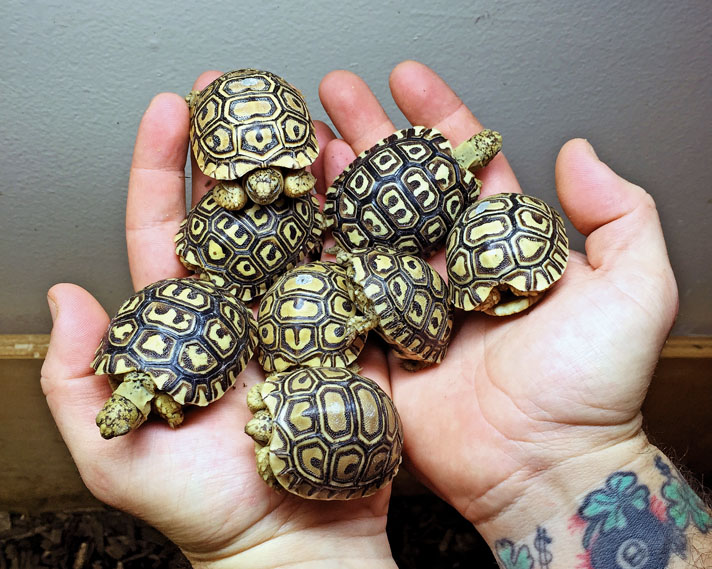
chris leone
The author holds a double-handful of cute—hatchling leopard tortoises.
Although leopard tortoises occur in semi-arid habitats in nature, water, along with humidity, is crucial to their survival and healthy growth. Dry substrate with little to no humidity, coupled with blazing-hot heat lamps, has resulted in the early deaths of an incalculable number of babies, and this method of keeping them is no longer accepted, nor does it make sense when compared to what they actually experience in their homeland.
Baby tortoises in the wild tend to congregate in moist areas under debris or plant matter after hatching, and they remain this way until they are of a less-vulnerable size. This microclimate subjects the babies to high levels of humidity, along with hydration, and it is pivotal to their successful development.
Even when feeding, these little gems do not have to put much effort into finding what they need because they often hide among food items such as grasses and weeds. The constant exposure to conditions such as these allow the hatchlings to grow steadily and smoothly.
The vast majority of leopard tortoises in captivity have severely pyramided carapace scutes, to the point where some appear extremely deformed. Like the Indian star tortoise (Geochelone elegans), leopard tortoises native to certain regions are prone to some natural raising of the carapace scutes, particularly the vertebrals, but deformation does not occur unless they are subjected to drought-plagued environments and a poor diet.
An excellent way to begin raising baby leopard tortoises is to start with a Rubbermaid tote, or one of the custom-built reptile cages available on the market. We use Herpcages (herpcages.com), which are made from high-impact polystyrene. They have hinged windows, side vents, solid tops with cut-outs for lighting.
Because leopard tortoises can lay fairly large clutches of eggs, we raise newly hatched groups of six to 12 hatchlings in 4 by 2-foot enclosures. Enclosures that are too small will cause overcrowding and stress, and if they’re too large, this may result in babies that become “lost” inside, and unable to locate needs such as water.
Inside, we provide 3 to 4 inches of substrate comprised of Nature’s Care organic potting mix with cypress mulch mixed in. It retains moisture but does not mold easily and is a bit more of a naturalistic choice. Substrates such as aspen shavings, rabbit pellets and walnut shell are all considered part of the outdated husbandry methods that are no longer advisable for success rearing any tortoise hatchling, including leopards.
Half-logs or driftwood pieces are provided for hiding places and to create visual barriers. For a daily water source, two or three terra cotta saucers are recessed into the substrate; providing more than one water dish increases the chances of the babies easily finding water. The same type of saucers can be used for food dishes.
For lighting, we use either 100-watt mercury vapor bulbs, which put out heat, UVB and UVA in one shot, or we use 75 to 100-watt indoor/outdoor floodlights by Phillips in combination with a Zoo Med T5 UVB-emitting 10.0 fluorescent strip bulb.
The substrate is kept moist, not by spraying it but by actually adding water to it. Spraying only allows the surface to moisten, which quickly dries up by the rising heat inside the enclosure. If kept in a warm room of 70 to 80 degrees Fahrenheit, the enclosure should reach an ambient temperature of the mid to high 80s, with a basking spot of around 100 degrees. The “closed-in” enclosures we use allow the humidity level to rise and hold steady around 80 percent or higher, which is excellent for the sensitive hatchlings (some keepers have had success constructing closed-in style units out of plywood, which can also work very well so long as the wood is protected from the humidity).
During the warmer parts of the year, baby leopard tortoises can be safely and successfully maintained outdoors in a small, well-drained pen that is protected from the elements and predators. An 8-by-8 foot unit can be made from landscape timbers purchased at stores such as Lowe’s or Home Depot. Divide the pen into sections to house different age groups comprised of hatchlings up to small juveniles in the 4-inch range.
A secure lid can be crafted using 2 by 3s, and fitted with strong, metal or wire mesh. Set on hinges with a latch added for more security will protect the youngsters from birds, raccoons or anything else that may look to make a meal out of them. The ground must not be a lawn or area that easily floods, but should be a soil, sand and gravel mix; the substrate in our outdoor baby enclosures is 50 percent soil, 10 percent sand and 40 percent pit or pea gravel. Half-logs and driftwood can again be used as décor, along with terra cotta saucers as food and water dishes.
The babies will need the sun to benefit from, but shade is crucial, too, to ensure they do not cook. Young tortoises can literally cook within minutes if they cannot escape the sun. Cover provided by boards, shade cloth, live plants (stonecrop, spirea, lavender, strawberry and sedums work great and are safe) and rocks will help protect babies leopard tortoises from overheating.
When temperatures remain in at least the low 70s at night, and higher in the day, we consider it safe enough to house baby leopard tortoises outside, and have never had an issue doing so.
Leopard Tortoise Enclosures
Adult leopard tortoises aren’t easy to accommodate if space is an issue, but it can be done, and we are living proof that success can be achieved even in the more northerly areas of the U.S. As a general rule of thumb when keeping almost all tortoise species, outside keeping when weather permits is the absolute best. In New Jersey, where I live, our leopard tortoises can safely reside outdoors from April until late October as long as seasons are “on time.” Leopard tortoises aren’t diggers, so sinking a retaining wall deep into the ground to prevent escapes is not necessary. They are, however, very strong and capable of knocking down a fence and scaling the corner of an enclosure if it isn’t secure or high enough.
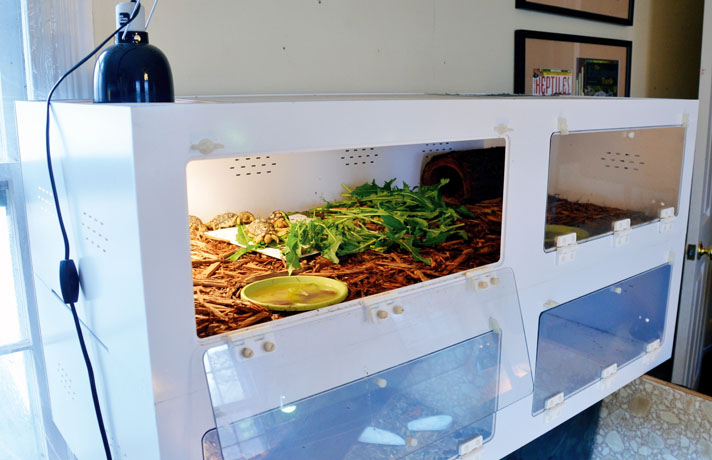
chris leone
The author likes to use Herpcages.com enclosures for hatchling leopard tortoises kept indoors.
An outdoor pen measuring 24 by 48 feet and with 2-foot-tall walls can be constructed using 12-foot-long, 12-inch-wide, pressure-treated planks. Create 12-foot sections by placing one plank on top of another, edge to edge, then attach them to a 4-foot-long post sunk 2 feet into the ground for support (see photo). An enclosure this size can comfortably house a group of up to eight adult leopard tortoises.
Leopards are not aggressive and do very well in communal groups, even with multiple males. Stacking the planks two or three high should make the pen’s walls tall enough to prevent escape. We do not construct lids for pens of this size, especially because predation of large tortoises is not a danger in our area.
At night, the tortoises are locked into a small, heated shed located in a far corner inside the pen. A bed of straw is provided inside, and several light fixtures hold 250-watt, infrared heat lamps that are turned on when nighttime temperatures are expected to slip below 65 degrees. The tortoises quickly learned to retreat to this shed at the end of the day.
The pen is located in a bright, sunlit area on ground that is not subjected to any major flooding. Part of it provides grass, while the rest is a more barren terrain of soil, gravel and sand, similar to what we provide hatchlings that are housed outdoors, as described previously. Large logs cut from trees around the property are used inside the pen as visual barriers and décor. Hardy grasses, including maiden and fountain, are planted in the enclosure, offering the tortoises shady areas they can scrape into. Planting anything that leopard tortoises would find edible simply doesn’t work, as the tortoises will instantly trample and consume such plants. Planting some hibiscus trees that are tall enough to be out of the tortoises’ reach works well, and they will enjoy any of the tree’s leaves and flowers that you care to offer.
Watering areas in the form of large, stainless-steel bowls are sunken into the ground because, as with any tortoise, water is crucial, especially in the heat of summer. Leopard tortoises do enjoy rain and appreciate puddles. In nature, they have even been observed swimming in considerable depths and are said to be able to submerge for up to 10 minutes! Ours appreciate a muddy section of the pen after a torrential downpour, as they soak and drink freely.
Our adults waste no time starting their day during the summer, moving to the spot in the pen where the morning sun hits hardest. Here, they warm up and begin their grazing routine. During the hot peak of the day they generally seek refuge in the shed, in a corner, or under some grass before resuming activity in the late afternoon-early evening. On cooler, rainy days, the tortoises are still allowed out of the shed, but the infrared lights inside the shed are turned on so they have the option of drying off in warmth.
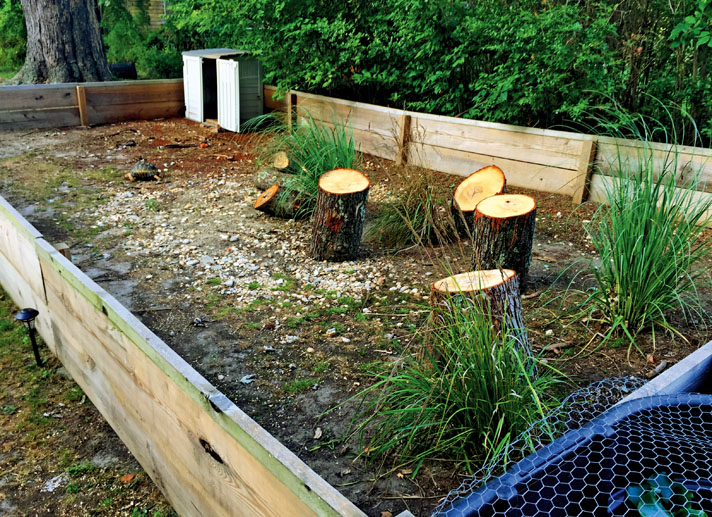
chris leone
An outdoor pen measuring 24 by 48 feet and with 2-foot-tall walls can be constructed using 12-foot-long, 12-inch-wide, pressure-treated planks.
Housing adult leopard tortoises indoors can prove to be a hassle, and we have found that less is more in this case. Simplistic but efficient indoor housing makes it easier to maintain the animals and keeps them safe.
Horse-stall type enclosures made from plywood were constructed in the basement in the form of 16-by-8-foot units. Each one houses three to four adult tortoises on a bed of deep cypress mulch and straw. Basking lights of 250 watts are hung from the rafters in various places so the tortoises have several basking sites. For females, planks are cut to corner off a section that allows for a deep nesting area comprised of top soil, sand and peat. A light is placed over this area, as well.
We keep the ambient temperature for the tortoises indoors in the low to mid 80s during the day and no lower than 65 degrees at night. The basking areas hold steady at between 110 and 120 degrees. Stainless-steel dishes provide water, and large ceramic plates are used as food areas.
Leopard tortoises defecate quite a bit, and inside, this can become uncomfortable for the keeper and the specimens. We remove feces daily.
Because the tortoises are usually kept indoors from November to April only, we do not offer them UVB lighting at this time. No issues have ever resulted from this, and tortoise health, along with reproduction, continues to remain at optimal levels.
What To Feed Leopard Tortoises
Leopard tortoises are grazers and, boy, can they eat! Healthy neonates all the way to adults will make a meal out of anything they find appealing, so it is important to keep them well fed. Because they are browsers, we offer food daily for babies and every other day for adults. While outside for the summer, the adults manage to consume at least something every day as they chomp on grass growing in the pen and fallen leaves from the trees.
Like most tortoises, leopards require high fiber and calcium in their diet. In addition to a natural graze on grass, items such as dandelion, plantain, mulberry and grape leaves, squashes, cactus pads, escarole, chicory and dark greens such as collard, mustard and turnip should be offered. We also have great success using a combination of Mazuri tortoise diet (original formula) and Zoo Med Grassland Tortoise Diet.
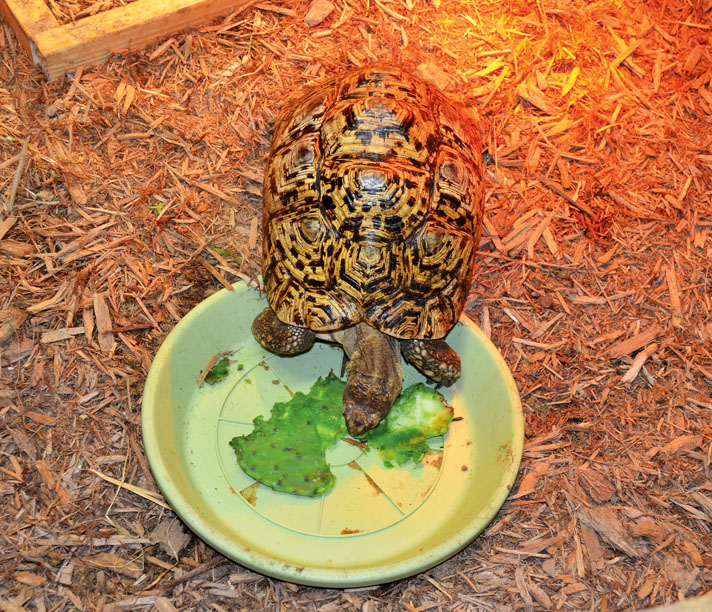
chris leone
In addition to cactus pads, items such as dandelion, plantain, mulberry and grape leaves, squashes, grass, escarole, chicory and dark greens such as collard, mustard and turnip should be offered.
Although leopard tortoises can handle a small amount of fruit in their diet, we never offer it. Babies and juveniles receive the same diet as the adults, but certain items are cut into more manageable pieces for them when they’re so young. We also supplement the diet for youngsters with calcium powder and multi-vitamin powder once or twice a week. We do not do this for the adults, but instead offer whole cuttlebone at all times, for them to use at their leisure. With exposure to the natural sun a good portion of the year, plus a proper diet, the adults simply to do require supplements to be forced upon them. I believe it’s more beneficial for them to take it on their own when they feel the need to.
Stigmochelys pardalis Are Super Popular With Tortoisekeepers
Today, Stigmochelys pardalis holds its head high in regard to popularity, and captive-bred hatchlings are available throughout the year. Pretty much wherever you live, success can be attained when keeping this beautiful tortoise. There is no question about why it remains firmly planted as one of the all-star species in the tortoise world, and they certainly can be heavyweights. The large size of some individuals may be one of their only downfalls, but that’s only if you prefer smaller tortoises. There’s nothing like having a mighty yet harmonious reptile lumbering about the yard. The friendly demeanor of a leopard tortoise, in conjunction with the prehistoric march the species exhibits while tromping around, is enough to captivate any keeper.
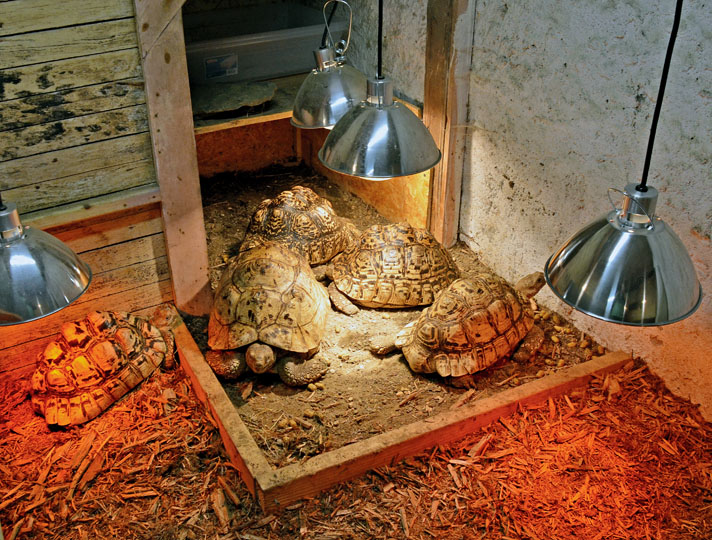
chris leone
A group of the author’s females basking beneath heat lamps in their indoor enclosure.
And that famed leopard pattern—that absolutely stunning leopard pattern could stop a bus! This tortoise is truly one of the most alluring on the planet today and although its markings may be flagrant, what may appear as a striking, highly contrasted and even breath-taking pattern to us is actually the tortoise’s way of blending right in via camouflage. So, if you’re lucky enough to find yourself out in the wilds of Africa, take a moment from observing the big cats or other prominent wildlife to peer into the surrounding vegetation. Let your eyes focus on the tranquility that lies within it, because you just might be looking at a leopard tortoise.
Chris Leone has kept and bred more than 50 species of chelonians and is the owner of Garden State Tortoise LLC and the Director of Animal Husbandry of theTurtleRoom. Visit him and his animals at gardenstatetortoise.com and theTurtleRoom.com.

